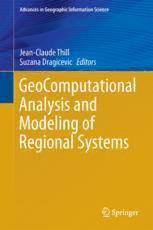Table Of ContentAdvances in Geographic Information Science
Serieseditors
ShivanandBalram,Burnaby,Canada
SuzanaDragicevic,Burnaby,Canada
Moreinformationaboutthisseriesathttp://www.springer.com/series/7712
Jean-Claude Thill • Suzana Dragicevic
Editors
GeoComputational Analysis
and Modeling of Regional
Systems
123
Editors
Jean-ClaudeThill SuzanaDragicevic
DepartmentofGeographyandEarth DepartmentofGeography
Sciences SimonFraserUniversity
UniversityofNorthCarolinaatCharlotte Burnaby,BC,Canada
Charlotte,NC,USA
ISSN1867-2434 ISSN1867-2442 (electronic)
AdvancesinGeographicInformationScience
ISBN978-3-319-59509-2 ISBN978-3-319-59511-5 (eBook)
DOI10.1007/978-3-319-59511-5
LibraryofCongressControlNumber:2017944436
©SpringerInternationalPublishingAG2018
Thisworkissubjecttocopyright.AllrightsarereservedbythePublisher,whetherthewholeorpartof
thematerialisconcerned,specificallytherightsoftranslation,reprinting,reuseofillustrations,recitation,
broadcasting,reproductiononmicrofilmsorinanyotherphysicalway,andtransmissionorinformation
storageandretrieval,electronicadaptation,computersoftware,orbysimilarordissimilarmethodology
nowknownorhereafterdeveloped.
Theuseofgeneraldescriptivenames,registerednames,trademarks,servicemarks,etc.inthispublication
doesnotimply,evenintheabsenceofaspecificstatement,thatsuchnamesareexemptfromtherelevant
protectivelawsandregulationsandthereforefreeforgeneraluse.
Thepublisher,theauthorsandtheeditorsaresafetoassumethattheadviceandinformationinthisbook
arebelievedtobetrueandaccurateatthedateofpublication.Neitherthepublishernortheauthorsor
theeditorsgiveawarranty,expressorimplied,withrespecttothematerialcontainedhereinorforany
errorsoromissionsthatmayhavebeenmade.Thepublisherremainsneutralwithregardtojurisdictional
claimsinpublishedmapsandinstitutionalaffiliations.
Printedonacid-freepaper
ThisSpringerimprintispublishedbySpringerNature
TheregisteredcompanyisSpringerInternationalPublishingAG
Theregisteredcompanyaddressis:Gewerbestrasse11,6330Cham,Switzerland
Preface
This volume addresses numerous research topics of GeoComputation as one of
the important scientific areas of research evolving from Geographic Information
Science. The book is the culmination of a few years of work that began with
a series of special sessions on GeoComputation organized at the 2012 North
American Meetings of the Regional Science Association International (RSAI)
in Ottawa, Canada. In addition, it complements the celebration of 21 years of
the GeoComputation conference series as a major scientific forum dedicated to
exchangingscientificadvancesinthisfield.
We would like to express our sincere thanks to all our colleagues and authors
who have participated in this project. They responded to our invitation and have
selflesslygiventheirtimeandefforttopassionatelycontributetothiseditedvolume
with chapters that cover various aspects of GeoComputation research. The twenty
chapters are arranged into three thematic parts: an overview of GeoComputation
asacross-disciplinaryfieldofresearchanditsrelevancetothescienceofregional
systems;variouscutting-edgeaspectsrelatedtoagent-basedandmicrosimulations
modeling; and finally the use of heuristics, data mining, and machine learning
approaches.
It was indeed a pleasure to work with the 45 contributing authors, and we are
thankful for their patience during the extended book editing process. We are also
thankfultoallthereviewers,authors,andexternalresearchers,whohavecontributed
with thoughtful comments to the blind peer review process and have strengthened
theoverallqualityandscientificrigorofthisbook.OurspecialthanksgotoTaylor
Anderson and Olympia Koziatek from the Spatial Analysis and Modeling (SAM)
Laboratory, Simon Fraser University, Canada, for assisting with the book editing
process. The editors’ support for this book project would not be possible without
funding from the Knight Foundation Endowment Fund at the University of North
Carolina at Charlotte and the National Science and Engineering Research Council
(NSERC)ofCanada.
v
vi Preface
This edited volume represents acoherent body ofknowledge rooted incutting-
edgescholarshipcoveringboththeoryandseveralapplicationdomainsthatwillbe
ofinteresttoGeoComputationresearchers,graduateandundergraduatestudentsas
wellasGISpractitionersinindustryandgovernmentagencies.
Charlotte,NC,USA Jean-ClaudeThill
Burnaby,BC,Canada SuzanaDragicevic
2017
Contents
PartI General
GeoComputationalResearchonRegionalSystems .......................... 3
Jean-ClaudeThillandSuzanaDragicevic
References ......................................................................... 6
CodeasText:OpenSourceLessonsforGeospatialResearchand
Education ......................................................................... 7
SergioJ.Rey
Introduction........................................................................ 7
PySAL ............................................................................. 8
LessonsforEducation............................................................. 13
LessonsforResearch.............................................................. 16
Conclusion......................................................................... 20
References ......................................................................... 21
ConsideringDiversityinSpatialDecisionSupportSystems ................ 23
NingchuanXiao
Introduction........................................................................ 23
KindsofDiversity................................................................. 24
EmbracingDiversity .............................................................. 30
Conclusions........................................................................ 33
References ......................................................................... 34
ParallelComputingforGeocomputationalModeling........................ 37
WenwuTang,WenpengFeng,JingDeng,MeijuanJia,andHuifangZuo
Introduction........................................................................ 37
ParallelComputing................................................................ 38
ParallelComputingforGeocomputationalModeling ........................... 41
vii
viii Contents
CaseStudy......................................................................... 46
Conclusion......................................................................... 50
References ......................................................................... 51
High-Performance GeoComputation with the Parallel Raster
ProcessingLibrary............................................................... 55
QingfengGuan,ShujianHu,YangLiu,andShuoYun
Introduction........................................................................ 55
KeyFeaturesofpRPL2.0......................................................... 58
ShowcasesandPerformanceAssessments....................................... 63
Conclusion......................................................................... 71
References ......................................................................... 72
PartII Agent-basedSystemsandMicrosimulations
‘Can You Fix It?’ Using Variance-Based Sensitivity Analysis
toReducetheInputSpaceofanAgent-BasedModelofLandUseChange 77
ArikaLigmann-Zielinska
Introduction........................................................................ 77
ComprehensiveUncertaintyandSensitivityAnalysisofAgent-Based
ModelsofLandUseChange...................................................... 79
ABMofAgriculturalLandConservationandModelSetup..................... 83
ResultsoftheOriginalABM ..................................................... 89
ModelSimplificationandDiscussion ............................................ 92
Conclusions........................................................................ 96
References ......................................................................... 96
Agent-BasedModelingofLarge-ScaleLandAcquisitionandRural
HouseholdDynamics ............................................................ 101
AtesmachewB.HailegiorgisandClaudioCioffi-Revilla
Introduction........................................................................ 101
RuralSystemsandLarge-ScaleLandAcquisition............................... 102
PriorAgent-BasedModelingonTraditionalSocietiesinRuralSystems....... 104
Setting,SituationandStudyArea ................................................ 105
TheOMOLANDModel .......................................................... 107
PolicyScenarios................................................................... 111
Results ............................................................................. 112
DiscussionandConclusion ....................................................... 115
References ......................................................................... 116
Spatial Agent-based Modeling to Explore Slum Formation
DynamicsinAhmedabad,India................................................ 121
AmitPatel,AndrewCrooks,andNaoruKoizumi
Introduction........................................................................ 121
ModelingofUrbanSystems ...................................................... 124
Contents ix
PriorEffortstoStudySlumFormationusingGeosimulation ................... 125
AGeosimulationApproachtoModelSlumFormation ......................... 126
CaseStudy:Ahmedabad.......................................................... 130
SimulationResults ................................................................ 133
DiscussionandFutureResearchDirections...................................... 137
References ......................................................................... 138
Incorporating Urban Spatial Structure in Agent-Based Urban
Simulations ....................................................................... 143
HaoyingWang
Introduction........................................................................ 143
ComponentsofAgent-BasedUrbanSimulation................................. 145
IncorporatingUrbanSpatialStructure............................................ 147
TransportationandCongestion:AnApplication................................. 148
ABMSimulation:LandDevelopmentandCongestion.......................... 152
ConcludingRemarks.............................................................. 162
References ......................................................................... 164
TheILUTEDemographicMicrosimulationModelfortheGreater
Toronto-HamiltonArea:CurrentOperationalStatusandHistorical
Validation ......................................................................... 167
FrancoChingcuancoandEricJ.Miller
Introduction........................................................................ 167
LiteratureReview.................................................................. 168
TheILUTEModelSystem........................................................ 170
OverviewoftheILUTEDemographicUpdatingModule....................... 172
DescriptionsofIndividualI-DUMProcesses.................................... 175
SimulationResults ................................................................ 179
DiscussionandFutureDirections................................................. 184
References ......................................................................... 186
PartIII Heuristics,DataMining,&MachineLearning
MachineLearningandLandslideAssessmentinaGISEnvironment..... 191
Miloš Marjanovic´, Branislav Bajat, Biljana Abolmasov,
andMilošKovacˇevic´
Introduction........................................................................ 191
RelatedWork ...................................................................... 192
ModelingPrinciples............................................................... 195
PracticalExample:HalenkoviceCaseStudy..................................... 201
Conclusion......................................................................... 209
References ......................................................................... 211
x Contents
InfluenceofDEMUncertaintyontheIndividual-BasedModeling
ofDispersalBehavior:ASimpleExperiment................................. 215
VincentB.Robinson
Introduction........................................................................ 215
Methodology....................................................................... 217
ResultsandDiscussion............................................................ 228
ConcludingComments............................................................ 233
References ......................................................................... 234
ASemi-AutomatedSoftwareFrameworkUsingGEOBIAandGIS
forDelineatingOilandWellPadFootprintsinAlberta,Canada .......... 237
VerdaKocabas
Introduction........................................................................ 237
Methodology....................................................................... 239
FeatureExtractionSystem........................................................ 243
AutomatedQualityControlSystem .............................................. 247
ResultsandDiscussion............................................................ 250
Conclusion......................................................................... 253
References ......................................................................... 255
ModelingUrbanLand-UseSuitabilitywithSoftComputing:The
GIS-LSPMethod................................................................. 257
SuzanaDragic´evic´,JozoDujmovic´,andRichardMinardi
Introduction........................................................................ 257
PropertiesoftheLogicScoringofPreference(LSP)Method................... 260
ApproachforDesigningGIS-LSPUrbanLandSuitabilityMaps............... 263
GIS-BasedLSPSuitabilityMaps................................................. 269
Conclusions........................................................................ 271
References ......................................................................... 273
AnAlgorithmicApproachforSimulatingRealisticIrregularLattices.... 277
JuanC.Duque,AlejandroBetancourt,andFreddyH.Marin
Introduction........................................................................ 277
ConceptualizingPolygonsandLattices .......................................... 280
TopologicalCharacteristicsofRegularandIrregularLattices .................. 283
RI-Maps:AnAlgorithmforGeneratingRealisticIrregularLattices ........... 286
Results ............................................................................. 297
ApplicationofRI-Maps........................................................... 299
Conclusions........................................................................ 300
References ......................................................................... 301
ARobustHeuristicApproachforRegionalizationProblems ............... 305
KamyoungKim,YongwanChun,andHyunKim
Introduction........................................................................ 305
LiteratureReview.................................................................. 306
ProblemStatement ................................................................ 310

